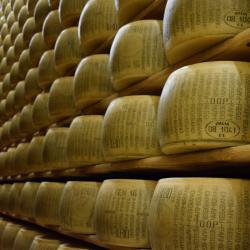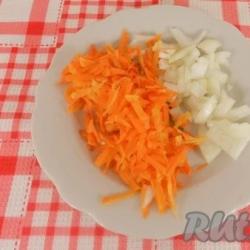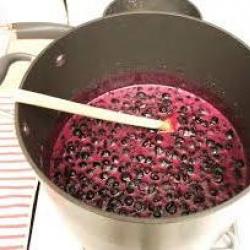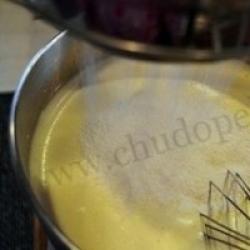Food preservative E235 Natamycin (pimaricin). Harm of preservative E235. Preservatives How to use preservative E235 for meat and fish
Natamycin (Natamycin, pimaricin, pimaricin, pimafucin, E235) is an antifungal antibiotic.
Used for the treatment and prevention of non-invasive intestinal candidiasis, infections of the skin and mucous membranes caused by Candida or other sensitive yeasts, yeast-like fungi or dermatophytes (balanoposthitis, otomycosis).
Also used as a preservative in the food industry as food additive E235.
Natamycin or pimaricin (food additive E235) - a strain produced during fermentation by bacteria Streptomyces natalensis. Additive E235 is slightly soluble in alcohol and water. However, natamycin is quite effective at very low concentrations. By its nature, natamycin is a natural antifungal agent and is used in the food industry as a preservative additive E235.
The E235 additive is non-toxic, but at high concentrations (more than 500 mg/kg body weight) it can cause nausea, vomiting, and diarrhea. Being an antibiotic, the E235 additive is added to food products in strictly limited quantities due to the properties of antibiotics to kill not only harmful fungi and bacteria, but also microorganisms involved in the vital processes of the human body.
For decades, the preservative E235 has been used in the food industry to prevent the development of fungi in dairy products, meat and other food products. Additive E235 can also be used in confectionery products: cakes, pastries, biscuits. In addition, the E235 additive is used in the production of cheese as its shell. As a result of surface treatment (irrigation of the surface or immersion in a solution of the finished product), the E235 preservative remains strictly on the surface of the cheese. Some countries allow the use of natamycin for surface treatment of sausages.
In addition to the food industry, natamycin is widely used in medicine as a polyene antibiotic of the macrolide group for the treatment of fungal diseases of the skin, mucous membranes, and gastrointestinal tract. Natamycin is widely used in the treatment of otitis externa; candidiasis of the skin and nails; dermatomycosis; intestinal candidiasis; fungal diseases of the oral cavity, such as acute pseudomembranous and acute atrophic candidiasis in patients with cachexia and immune deficiency and other diseases caused by pathogenic yeast fungi. Natamycin is used to make tablets, suspensions, creams, and suppositories.
In many countries, the use of E235 additive in the food industry is strictly prohibited. In Ukraine and Russia, pimaricin is approved for use in food products as a preservative additive E235.
The beneficial properties, as well as the harm, of the food preservative E235 Natamycin (pimaricin) have been scientifically proven and substantiated as a result of a number of studies, experiments and laboratory experiments. For this reason, the food preservative E235 Natamycin (pimaricin) was given the status of a “dangerous” food additive (in large quantities) for human life and health. However, at present, the food preservative E235 Natamycin (pimaricin) continues to be used in the food manufacturing process in the European Union, USA, Japan, Canada, Asia, as well as in the Russian Federation and neighboring countries.
Harmful food preservative E235 Natamycin (pimaricin)
True, taking into account the possible negative consequences of the harm of the food preservative E235 Natamycin (pimaricin) for the human body, doctors have established maximum permissible standards for the content of the dangerous chemically active substance natamycin in food products. In addition, you should remember the maximum permissible daily dosages of food consumption that contain the food preservative E235 Natamycin (pimaricin) in their chemical composition. It is believed that the body of an adult and healthy person can easily tolerate up to 0.3 mg/kg of body weight.
An overdose of pimaricin or natamycin may cause undesirable negative consequences in the form of allergic reactions or rashes on the skin. Unlike many other food preservatives E235 Natamycin (pimaricin) does not have a toxic or carcinogenic effect. However, the biologically active substance natamycin or pimaricin, which is included in the chemical composition of the food preservative E235 Natamycin (pimaricin), has such powerful antibacterial abilities that it destroys not only pathogenic, but also beneficial bacteria and microorganisms.
The exceptional benefit, as well as the main harm, of the food preservative E235 Natamycin (pimaricin) lies precisely in the distinctive antibacterial abilities of the chemical compound. Doctors believe that you should eat foods that contain the food preservative E235 Natamycin (pimaricin) as little as possible. Preservative E235 is classified as a synthetic and derivative chemical compound. The bacteria Streptomyces natalensis undergo a fermentation process; as a result of a chemical reaction, they release the biologically active substance natamycin, which is part of the preservative E235 and determines the exceptional properties and characteristics of the final chemical compound.
It is noteworthy that natamycin is a substance of natural origin. The main feature of the food preservative E235 Natamycin (pimaricin) can be considered the ability of the chemical substance to prevent the emergence and development of pathogenic bacteria, as well as fungi. Most often, the food preservative E235 Natamycin (pimaricin) is used in the production of meat products and semi-finished products, fermented milk products, as well as sweets and confectionery products.
In addition, the food preservative E235 Natamycin (pimaricin) has found wide use in the pharmaceutical industry. A food preservative is included in most medicines that help in the treatment of various types of diseases of the gastrointestinal tract and skin. Natamycin helps in the treatment of dermatitis, candidiasis and other diseases resulting from the harmful effects of yeast pathogenic fungi.
Pimaricin (E235) - C33H47NO13; other names: natamycin, mitrocin. Obtained by cultivating Streptomyces natalensis. It has an antimicrobial effect against yeast of the genus Candida, affecting cell membranes. It acts against yeast, mold fungi and does not act against bacteria, viruses and actinomycetes; it is effective against fungi that infect human skin. It is used in cheese making to protect the surface of cheeses and in sausage production.
[Nechaev A.P., Traubenberg S.E., Kochetkova A.A., Food chemistry, 2003]
Natamycin E235 . It has other names - pyramycin, mitrocin. It has an antimicrobial effect on yeast and molds, but has no effect on bacteria, viruses and actinomycetes. It is used to a limited extent in cheese making for surface treatment and in sausage production in an amount of 0.4%.
[Educational and methodological materials “Food concentrates and additives for processed products” Kasymov S.K., Ph.D., 2013]
Antibiotics
A special group of food additives that slow down the spoilage of food products (meat, fish, poultry, vegetables, etc.) are antibiotics. Antibiotics approved for medical use are not allowed for use in the manufacture of food products and semi-finished products. The use of antibiotics makes it possible to preserve food raw materials and some types of food products for a longer time, sometimes extending their shelf life by 2-3 times. However, the use of antibiotics can lead to undesirable consequences, including disruption of the normal ratio of microorganisms in the gastrointestinal tract. Antibiotics are usually used to treat fresh, perishable foods (meat, fish, fresh plant products). Technological methods for using antibiotics are different: immersing the food product in a solution of antibiotics for a limited period, irrigating the surface of the food product with solution of antibiotics of various concentrations, administration of antibiotics before slaughtering animals, etc. Antibiotics added directly to the food product have gained some popularity in the food industry: nisin and pim aricin.
The characteristics of currently used food ingredients (food additives, flavorings, technological aids) and biologically active additives are considered.
The Dictionary of Food Additives consists of dictionary entries following a single structure, described at the beginning of the book, and arranged in ascending order of E-indices. Dictionary entries about additives that are not assigned E-indices are placed at the end of the dictionary and arranged in alphabetical order.
Stabilizers, thickeners and gelling agents widely used in various branches of the food industry are described. Almost all currently known substances of this group are considered, their chemical formulas and properties are given, sources and methods of preparation are indicated. The book is intended for food industry specialists, and will also be useful to students and graduate students of specialized higher educational institutions.
Natamycin (international name - natamycin) is an antifungal drug and a preservative of natural origin. Other common names for natamycin are pimaricin and delvocid. In the generally accepted classification of food additives, this preservative has the index E235.
According to its chemical structure, natamycin is an antibiotic that prevents the development of yeast and yeast-like fungi. The main area of application of natamycin in the food industry is protection against molding of sausages and cheeses.
Benefits of Natamycin
The main advantages of natamycin, which distinguish it favorably from other antifungal preservatives:
- high efficiency: natamycin inhibits yeast and mold in food;
- low cost: the use of the E235 additive has virtually no effect on the final price of the product, and taking into account the cost reduction, it even allows you to reduce it!
- natural origin: thanks to natamycin, you can refuse to use artificial preservatives;
- absence of taste and odor: natamycin allows you to preserve all the original characteristics of the product;
- positive effect on the appearance of goods: products treated with natamycin look clean;
- Due to its properties, the food additive E235 does not interfere with the ripening of cheeses and sausages.

Use of natamycin
When using natamycin, it should be borne in mind that it is effective against a variety of fungi, but does not act against bacteria, viruses and other microorganisms. As a result, E235 is used exclusively for external processing of food products by spraying or immersion. In this case, it is possible to process both the finished product as a whole and separately the shell by soaking.
An important advantage of the preservative: it practically does not penetrate into the product, remaining only on the surface!

Safety of natamycin
Modern research shows that natamycin has no toxic or carcinogenic effect and is completely safe if the permissible dosages are observed.
However, being an antibiotic, natamycin can affect both harmful fungi and organisms beneficial to the intestinal microflora. In this regard, natamycin is used exclusively for treating the external surface of the product, and its content in the substance itself is limited.
MINSK, March 3 – Sputnik. Rosselkhoznadzor may impose a ban on the import of cheeses from two Belarusian milk processing enterprises, the Izvestia newspaper reports, citing the department’s press service.
Earlier, Rosselkhoznadzor introduced a regime of enhanced control over nine Belarusian enterprises of both meat and dairy products. In particular, dairy processing enterprises were accused of using the undeclared preservative natamycin in the production of cheeses. In some products where this preservative was declared, its concentration exceeded the permitted parameters.
According to Rosselkhoznadzor press secretary Yulia Melano, the Belarusian Oshmyany Cheese Factory OJSC (a branch of the Lida Milk Canning Plant OJSC) and the cheese production branch of Rogachevsky MKK OJSC are one step away from a ban on the import of products.
“If violations are discovered at least once again under the enhanced control regime, we will raise the issue of banning supplies from these enterprises. Or ask the Belarusian side to introduce self-restraint,” Melano said.
What violations are we talking about?
In February, Rosselkhoznadzor took strict control over nine Belarusian enterprises. Of the “milkmen”, four factories came under strict supervision:
- Molodechno Dairy Plant, Volozhin branch (undeclared preservative natamycin in cheese)
- Lida Milk Canning Plant (undeclared preservative natamycin in cheese, three cases)
- Rogachevsky MKK, cheese production branch (exceeding the amount of natamycin preservative in cheese, three cases)
- JSC "Babushkina Krynka" (exceeding the amount of preservative natamycin in cheese).
Rosselkhoznadzor has previously made complaints about Belarusian meat and milk, but in Minsk they always responded that we are talking about counterfeit products produced in the Russian Federation or in other countries and imported into Russia under the guise of Belarusian ones.
Meanwhile, at the end of February, answering a question from Russian media about the reasons for introducing strict supervision, the head of Rosselkhoznadzor Sergei Dankvert emphasized that all identified pathogenic microorganisms and bacteria, as well as undeclared antibiotics and preservatives, were found in Belarusian products, we are talking about counterfeit here doesn't work. Dankvert explained that the samples were taken from products that were traveling in trucks with Belarusian license plates directly at the border, so the department has no doubt about its origin.
What is natamycin?
Natamycin is a food preservative and is designated E235. Its beneficial properties, as well as its harm, have been scientifically proven and substantiated as a result of a number of studies, experiments and laboratory experiments. For this reason, the food preservative E235 Natamycin (pimaricin) was given the status of a “dangerous” (in large quantities) food additive for human life and health. However, at present, the food preservative E235 Natamycin (pimaricin) continues to be used in the food manufacturing process in the European Union, USA, Japan, Canada, Asia, as well as in the Russian Federation and neighboring countries.
Taking into account the possible negative consequences of the use of natamycin, doctors have established its maximum permissible levels in food products. It is believed that the body of an adult and healthy person can easily tolerate up to 0.3 mg/kg of body weight.
Unlike many other food preservatives E235 Natamycin (pimaricin) does not have a toxic or carcinogenic effect. However, the biologically active substance natamycin or pimaricin, which is part of the chemical composition of the food preservative E235 Natamycin (pimaricin), has such powerful antibacterial abilities that it destroys not only pathogenic, but also beneficial bacteria and microorganisms.
Most often, the food preservative E235 Natamycin (pimaricin) is used in the production of meat products and semi-finished products, fermented milk products, as well as sweets and confectionery products.
In the food industry, including the production of cheese, it is used to prevent mold from appearing on the surface of cheese due to improper storage conditions.
Meanwhile, doctors note that natamycin is also an antibiotic. In their opinion, unjustified use of natamycin can provoke the development of resistance to this antibiotic in a person, and in the future, if a person develops a disease that requires treatment with antibacterial drugs, other, more “severe” drugs will have to be selected.
The company Kirsch LLC begins supplying preservatives produced by the Turkish company Maysa Gida San to Russia. These effective antibacterial agents of natural origin can be successfully used to replace chemical preservatives in the production of a wide range of products in the meat, dairy, confectionery, baking industries and especially in cheese making.
MAYMICIN® NATAMYCIN is a natural antifungal drug produced by the bacteria Streptomyces natalensis. Indispensable in the production of cheese.
TECHNICAL INFORMATION
M A Y M I C I N ® NATAMYCIN
MAYMICIN ® NATAMYCIN is a food additive E235 Natamycin, a naturally occurring preservative, is used in the processing of dairy, meat and cheese foods to protect against mold and yeast, extend the shelf life of food and reduce transportation costs. MAYMICIN ® NATAMYCIN does not affect the taste, aroma and color of food and is safe for the consumer, and does not cause allergic reactions.
Activity
MAYMICIN ® NATAMYCIN has an antifungal effect against most types of molds and yeasts. The favorable pH value for the activity of MAYMICIN ® NATAMYCIN is from pH 3.0 to 9.0. It will not affect the appearance, taste or texture of food. MAYMICIN ® NATAMYCIN is stable at room temperature. Sunlight, oxidizing agents, heavy metals may affect the activity of MAYMICIN ® NATAMYCIN. MAYMICIN ® NATAMYCIN is adapted for use as a food preservative, but cannot inhibit bacterial growth.
Application of MAYMICIN ®
NATAMYCIN
MAYMICIN ® NATAMYCIN, as an effective natural food preservative, can be used in a number of products with local regulatory approval. Some uses of MAYMICIN ® NATAMYCIN are listed below:
1 )MAYMICIN ® NATAMYCIN products may inhibit mold growth during storage cheese, as well as toxins produced by mold. There are three methods that can be used for cheese.
I. spraying a suspension of MAYMICIN ® NATAMYCIN from 0.5 g / l to 2.8 g / l on the surface of the cheese
II. Immersion of salted cheese in MAYMICIN ® NATAMYCIN suspension from 0.5 g/l to 2.8 g/l for a period of time from
2 to 4 minutes.
III. Mixing with cheese shell 0.1 g/kg MAYMICIN ® NATAMYCIN.
Used in yoghurts, adding 5-10mg/kg MAYMICIN ® NATAMYCIN can highly effectively extend shelf life by more than 3 weeks.
2) Bread and cakes (baked goods)
Spraying a suspension of MAYMICIN ® NATAMYCIN in a proportion of 0.1 g / kg to 0.5 g / kg on the surface of the cake, pre-fried dough will effectively prevent and suppress the growth of mold and yeast.
3) Meat products
Spraying or immersing products in a suspension of MAYMICIN ® NATAMYCIN in a proportion of 0.5 g / l to 2.0 g / l will create a protective film of up to 0.004 mg / cm² of surface. Mold and yeast will
effectively suppressed. Spraying (or dipping) sausages into a MAYMICIN ® NATAMYCIN suspension in a ratio of 0.5 g/l to 2.0 g/l will significantly increase shelf life. MAYMICIN ® NATAMYCIN can also be used for other types of products such as grilled meats, dried fish, etc.
4) Fruit juice
Various fruit juices are rich in sugars and organic acids, which promote yeast growth. The use of MAYMICIN ® NATAMYCIN will increase the stability of products during storage.
·
10 mg/kg MAYMICIN ® NATAMYCIN can inhibit the growth of yeast in concentrated orange
juice at 10°C, but the dosage of MAYMICIN ® NATAMYCIN can be increased to 20 mg/kg for inhibition
yeast growth at room temperature.
·
30 mg/kg MAYMICIN ® NATAMYCIN can inhibit fermentation for 6 weeks, and taste and
The texture of the apple juice will not change.
·
20 mg/kg MAYMICIN ® NATAMYCIN can inhibit the fermentation of grape juice caused by
yeast, 100 mg/kg MAYMICIN ® NATAMYCIN can prevent fermentation completely.
·
70 mg/kg MAYMICIN ® NATAMYCIN can inhibit mold and yeast in tomato juice.





